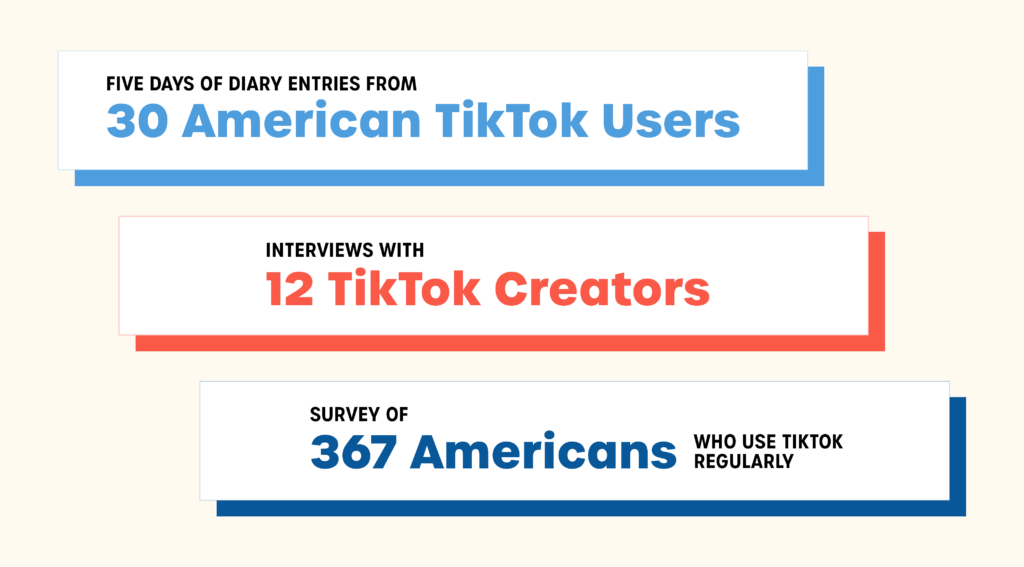
Sign up for Powell Tate Insights for monthly fresh takes on disruptions, innovations and impact in public affairs.
TikTok may be the most consequential, least understood media platform in America. The Weber Shandwick Collective’s (TWSC) groundbreaking multi-modal research on U.S. TikTok users and creators is seeking to change that.
About half of all Americans – 170 million people – consume content on TikTok, according to the platform itself. But the fact that no two people’s “For You” content feed looks exactly the same, with no need to have a single friend in the network, makes it difficult to understand how it is curated or its place in American media. A well-documented lack of data available for studying the platform makes it even more challenging to understand its role in shaping public opinion and debate on current events, politics and social issues.
To shed new light, TWSC learned directly from TikTok users and creators. This first-of-its kind study combines qualitative and quantitative insights from both TikTok users and creators, including:

Mis- and disinformation are expected, accepted
Most TikTok users in our panel, across the political spectrum, said they are aware that the content they see on TikTok can be false or misleading. Several implied that the presence of false or misleading information is less of a problem and more of a benefit; it signals that TikTok is connecting them to the “real” world. As one panelist, a 21-year-old female identifying as a firm Democrat, put it, “I feel like it’s more realistic and tells the actual truth rather than the sugarcoating and what the government/leaders want us to hear. I am learning things and not just…accepting what is being told to me.”
Many express confidence in their ability to spot misleading information and do their own factchecking
Many panelists acknowledged there is misleading information on TikTok. But they expressed confidence in their ability to discern fact from fiction by explaining how they employ techniques such as reading comments or using TikTok search to investigate claims.
Comments are king
A majority of our panelists said they read the comments on TikTok videos at least some of the time, and about one-quarter said they read them “all the time.” Creators also acknowledge the importance of reading and engaging in the comments but said it can tax their mental health.
TikTok is where news breaks
People from across the political spectrum in our panel said that it’s often a TikTok video that first alerts them to major news or trending political debates. “I hear stuff in TikTok, and then two weeks later the giant news outlets finally cover it,” remarked one 22-year-old, female panelist who identifies as a political independent. Our survey results validated this phenomenon: 77% of users said TikTok is where they first learn about news on political or social subjects, at least some of the time.
First-person video imparts credibility
When the people in our panel saw news, it was frequently a raw, self-produced, first-person video from a source appearing to be a peer user or independent creator – not a professional news organization like The New York Times, NBC or FOX News. Many Democrats, Independents and Republicans in our group agreed: News on TikTok “feels real” because it gives them an “unfiltered” connection to others like them.
“For You” reinforces pre-conceived notions
The sensitivity of the “For You” algorithm means that TikTokers consume information that bolsters their pre-existing points of view. The platform provides them with “talking points” on issues they care about.
Don’t expect a trickle-down effect
Don’t wait for your news or communications to organically spread from legacy news outlets to TikTok. Set the tone and framing of your news and information by breaking it on TikTok with a spectrum of creators sympathetic to your point of view.
Make it personal
Consider mimicking the raw, “unfiltered” aesthetic when you show up on the platform with your own content.
Prioritize ally activation
TikTok’s “For You” algorithm has an uncanny ability to find and activate individuals already predisposed to agree with you. Use it to maximize your advantage by focusing strategy and effort on recruiting and activating allies versus alternative goals, like persuading the “movable middle” or neutralizing detractors.
Be a partner and resource to creators
Find like-minded creators and arm them with evidence and talking points that promote your viewpoint. They also know their audience and don’t want to find themselves on “the wrong side” of TikTok. Give them space to offer feedback and adapt your message so it lands, and manage expectations about their ability to be effective on issues they aren’t very close to.
Don’t forget the comment section
While there are no view metrics for comments, reading them is such a common behavior that it is clear this is an opportunity for influence. Engage with them proactively, whether you are correcting the record or raising the visibility of an idea.
But engage with comments cautiously
Many comments are strictly performative, because it’s clear there is attention to be gained. Other comments can be genuine, but combative. While the algorithm excels at matching video content with people that will like it, it’s still possible for adversaries to find and infiltrate the comment section. A detailed protocol for engagement in the comments on your own TikTok videos or videos posted by others is a must – along with advice from platform experts.
Interrogate the sourcing and substance of insights about TikTok
Embrace multi-modal research and insights approaches to gain a clearer understanding of the platform. Consult with experts to build an ecosystem of data suppliers and analytical methodologies that give consistent foresight into risks and opportunities on TikTok.
Sign up for Powell Tate Insights for monthly fresh takes on disruptions, innovations and impact in public affairs.